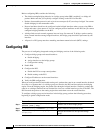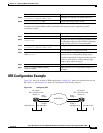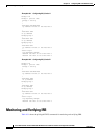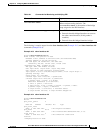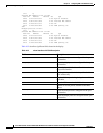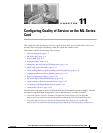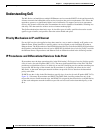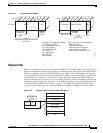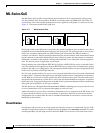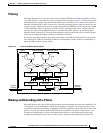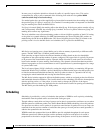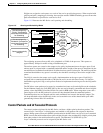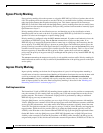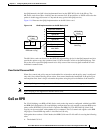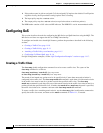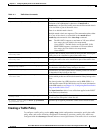
11-4
Cisco ONS 15310-CL and Cisco ONS 15310-MA Ethernet Card Software Feature and Configuration Guide R8.5
78-18133-01
Chapter 11 Configuring Quality of Service on the ML-Series Card
ML-Series QoS
ML-Series QoS
The ML-Series QoS classifies each packet in the network based on its input interface, bridge group
(VLAN), Ethernet CoS, IP precedence, IP DSCP, or resilient packet ring (RPR)-CoS. After they are
classified into class flows, further QoS functions can be applied to each packet as it traverses the card.
Figure 11-3 illustrates the ML-Series QoS flow.
Figure 11-3 ML-Series QoS Flow
Policing provided by the ML-Series card ensures that attached equipment does not submit more than a
predefined amount of bandwidth (Rate Limiting) into the network. The policing feature can be used to
enforce the committed information rate (CIR) and the peak information rate (PIR) available to a
customer at an interface. Policing also helps characterize the statistical nature of the information allowed
into the network so that traffic engineering can more effectively ensure that the amount of committed
bandwidth is available on the network, and the peak bandwidth is over-subscribed with an appropriate
ratio. The policing action is applied per classification.
Priority marking can set the Ethernet IEEE 802.1p CoS bits or RPR-CoS bits as they exit the ML-Series
card. The marking feature operates on the outer IEEE 802.1p tag, and provides a mechanism for tagging
packets at the ingress of a QinQ packet. The subsequent network elements can provide QoS based only
on this service-provider-created QoS indicator.
Per-class flow queuing enables fair access to excess network bandwidth, allows allocation of bandwidth
to support SLAs, and ensures that applications with high network resource requirements are adequately
served. Buffers are allocated to queues dynamically from a shared resource pool. The allocation process
incorporates the instantaneous system load as well as the allocated bandwidth to each queue to optimize
buffer allocation. Congestion management on the ML-Series is performed through a tail drop mechanism
along with discard eligibility on the egress scheduler.
The ML-Series uses a Weighted Deficit Round Robin (WDRR) scheduling process to provide fair access
to excess bandwidth as well as guaranteed throughput to each class flow.
Admission control is a process that is invoked each time that service is configured on the ML-Series card
to ensure that QoS resources are not overcommitted. In particular, admission control ensures that no
configurations are accepted when the sum of committed bandwidths on an interface exceeds the total
bandwidth on the interface.
Classification
Classification can be based on any single packet classification criteria or a combination (logical AND
and OR). Classification of packets is configured using the Modular CLI class-map command. For traffic
transiting the RPR, only the input interface and/or the RPR-CoS can be used as classification criteria.
96498
Policing & MarkingClassification
QoS Actions at Ingress QoS Actions at Egress
Queueing & ScheduleingClassification



